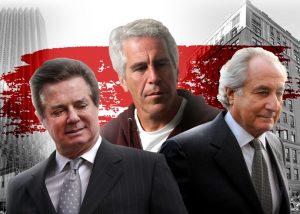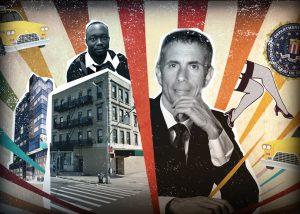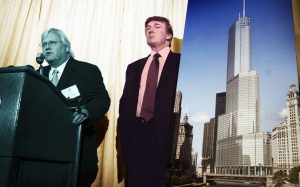Trending
The best of: TRD reporters share their picks for top stories of 2019
From botched building sales to an interview with Ben Carson, TRD reporters round up their favorite stories of the year

From troubles at SoftBank-backed startups and botched building sales, to big interviews with key players — including a Trump cabinet member — The Real Deal’s reporters continued to deliver hard-hitting coverage of the industry in 2019.
Here’s a look at some of the most compelling TRD stories of the year, curated by the reporters themselves:

From left: Paul Manafort with Trump Tower, Jeffrey Epstein, and Bernie Madoff with 133 East 64th Street (Credit: Getty Images, CityRealty, and Wikipedia)
Rich Bockmann, New York associate web editor
“How do brokers get listings from the DOJ?”: There’s no spectacle quite like watching New York’s rich and powerful take a perp walk. Add in real estate worth millions or tens of millions of dollars, and it brings it to a whole other level. But when the government seizes those properties, how exactly does it go about choosing the brokers who will ultimately sell them? As it turns out, the United States Marshals Service has a contract with Colliers International to oversee the sale of all forfeited properties.
Sylvia Varnham O’Regan’s story cleverly goes behind the scenes and takes a look at how some 600 to 700 forfeited properties get sold each year. It even points readers to the nondescript Real Look website where buyers can peruse listings for forfeited properties such as Paul Manafort’s Soho apartment. The story came out just after the death of Jeffrey Epstein, and I think it’s a fresh take on a real estate angle that had been written about often. The addition of Warburg Realty agent Jason Haber as a character who’s navigating the process along with the reader is a nice touch that really makes the story come to life.

Israeli financier Jonathan Leitersdorf
Kathryn Brenzel, New York senior reporter
“How an FBI agent, strip club owners and cab drivers decimated this High Line luxury project”: This story has everything — tenant-harassing strip club owners, a developer who touts “beautiful views of Jersey,” a group of taxi drivers who know their way around SRO laws and big questions about rent stabilization in New York. Kevin Sun’s story beautifully unpacks the series of bizarre developments that have prevented the owners of the Chelsea Highline Hotel from turning the property into a luxury tower. It’s a great example of the interesting narratives that can be unearthed by digging through legal documents and by taking a closer look when progress seems to halt at a development site.

The Coca-Cola building at 711 5th Avenue (Credit: Google Maps and iStock)
E.B. Solomont, Senior reporter
“The inside story of Coca-Cola’s botched building sale”: One of my favorite stories of 2019 was David Jeans and Rich Bockmann’s insider-y account of how Coca-Cola sold its iconic Midtown office building — but left tens of millions of dollars on the table. To me, the story has all of the elements of a New York real estate drama including a spurned buyer, default, a lawsuit and, ultimately, a massive property flip.
It all started when Coca-Cola’s real estate division sold 711 Fifth Avenue to Nightingale Properties and Wafra Capital Partners for $909 million in October, even though it came in lower than a $955 million offer from investor Michael Shvo. A month later, Wafra sold its stake to Shvo in a deal valuing the property at $937 million.
To find out why and how Coke seemingly botched the deal, Jeans and Bockmann hit the phones and talked to a dozen people who opined on where beverage giant went wrong. Some said Coke was wary of Shvo’s 2018 indictment on tax charges. Others said an important tenant scuttled Shvo’s bid for fear that he would convert the building to a hotel. There were just so many layers to the story, including Cushman & Wakefield’s role representing Coke and simultaneously advising Nightingale.

Adam Hochfelder at the Playboy Club’s opening party with singer Robin Thicke (Alamy Images)
Mary Diduch, New York data journalist
“The Playboy Club was a chance at redemption for Adam Hochfelder — here’s what went wrong”: This stood out among TRD’s stories this year for the sheer time and effort that reporter Erin Hudson, and the editors, put into making this story come to fruition. Hudson spent almost a year reporting it, which required gaining the trust of sources and poring through records and documents to piece together what was really going on with the Playboy Club, the latest project from controversial investor Adam Hochfelder. Hudson’s piece also wove in details that helped bring the story to life — from the decor of the infamous club to a breakdown of how the establishment ultimately met its demise. And, concerningly but importantly, Hudson’s piece opened with the challenges reporters can face during investigations: During her reporting, Hochfelder himself, “wearing a tailored suit with his hair slicked back,” showed up to TRD’s office, demanding to meet with the publisher. But even if one were to unwisely skip over the story, the piece is also notable for the creative comic-strip graphics that accompanied it.

(Illustration by Laurène Boglio / @boglio_boglio)
Erin Hudson, New York reporter
“Elevated risk”: Every day, New Yorkers take millions of elevators rides and most would never wonder if they’re endangering themselves. But an investigation by my colleagues Kathryn Brenzel and David Jeans shattered my sense of security, and it should give you pause too. They found that New York City’s system for maintaining and repairing its 63,000 passenger elevators is chronically broken and in extreme cases it’s costing lives. Though some trade groups and lawmakers are advocating for change, making the city’s elevators safer remains a low priority, and many aren’t even aware of the problem. The piece sheds light on the preventable tragedies that our city and industry (which has a track record of lobbying against such efforts) could band together to stop. It’s a haunting must-read you’ll recall every time you take a shaky elevator ride.

Ben Carson (Photos by Stephen Voss)
David Jeans, New York reporter
“Ben Carson vs. the critics”: Keith Larsen’s interview with HUD Secretary Ben Carson provided a unique opportunity to ask why a beloved American hero would throw away all of his achievements to lead the troubled federal housing department. Negotiating the interview itself was a battle and testament to Keith’s previous reporting on the secretary. And it elicited some fantastic moments. Keith asked why Carson was one of the few original Trump cabinet members left. The secretary responded: “I can afford $900 [per hour] lawyers.”

(Illustration by Kotynski)
Georgia Kromrei, New York reporter
“NYC’s ghost towers”: This story was on the cover of the first issue I took home after an initial interview at TRD. So, I devoured it — in part because I was hoping to get the job — and was really impressed with the ambition of the story. While other publications were mostly writing about the pied-à-terre tax getting killed in Albany, E.B. Solomont and Kevin Sun went farther, and looked at who buys these condos and why. It provided a fascinating inside view of New York City’s ultra luxury second home market. The kicker drives the article’s point home, from Brown Harris Stevens’ Sophie Ravet, who was candid about one of her clients, a Canadian investor looking for a $4 million condo to rent out: “I spoke to him last week and he said, ‘I don’t care where it is in the city, just find me the best deal. I just want to park that money.’”

(Illustration by Charis Tsevis)
Eddie Small, New York reporter
“Revealed: Corcoran’s ‘hacked’ files”: When Corcoran Group documents with information about its agents’ gross commission income, commission splits, marketing budgets and more were leaked this year, it shook the residential brokerage industry like few events before or since. TRD’s anonymized analysis of the data shed an extremely rare light on the health of one of New York’s most prominent brokerages and on how Corcoran manages its agents. It also raised a number of complex questions on TRD’s end about how to best handle having and publicizing data that was leaked in what Corcoran describes as a criminal incident. Reporters E.B. Solomont and Erin Hudson, along with researcher Ashley McHugh-Chiappone, expertly navigated the data and the ethical questions surrounding it to produce one of TRD’s most compelling stories of the year.

Bank OZK CEO and Chair George Gleason (Illustration by Chris Koehler)
Kevin Sun, New York data journalist
“Why NYC’s most important construction lender may be on shaky ground”: A lot has been written about this “little bank that could” over the years, as Bank OZK has emerged as one of the country’s most significant construction lenders. Reporters David Jeans and Keith Larsen were able to uncover fascinating new information about the bank’s rise and its recent struggles, from the legislative wrangling in Arkansas that allowed OZK to shed its holding company and switch regulators in 2017, to the great lede which features a private jet u-turning mid-flight as vice chair Dan Thomas leaves the bank. Thomas’ departure, together with reports of infighting, sexual misconduct and age discrimination as the bank’s deal volume has also begun to slow, raise important questions about the financial footing of one of this cycle’s most important real estate financiers.
Sylvia Varnham O’Regan, New York reporter
“It’s over for Barneys”: Mary Diduch’s piece has so many great elements. It broke news, offered great context about the setbacks facing the retail market, and provided heartbreaking insight into the desperate scramble to keep Barneys alive. “Everybody at this company… has been working 24 hours a day … to try to achieve this goal,” Barneys’ attorney said at the time. I thought it also served as a good reminder of how much depth breaking-news stories can have when reporters know the market well.

Architect Adrian Smith and Donald Trump unveil renderings of Trump Tower Chicago at a news conference in 2003 (Credit: Getty Images)
Katherine Kallergis, South Florida deputy web editor
“How Trump Tower became Chicago retail’s biggest failure”: This is one of my favorite TRD stories of 2019. Reporters Alex Nitkin and Joe Ward laid out why the ground-floor retail space at the downtown Chicago skyscraper has not been leased — with the exception of one small salon — by speaking with brokers, a former Trump Organization executive, architects and diving into tax documents. (Among the space’s bigger problems has been its design and lack of visibility, prospective tenants said.) One quote stood out to me from a brokerage head in Chicago. “Retail is not that complicated, and the more complicated you make it, the worse it is,” he said. The story also shows how the Trump Organization appealed its property tax appraisal bill as a result, and how much potential revenue the company has missed out on.

(Illustration by Tim Peacock)
Keith Larsen, South Florida reporter
“Katerra promised a tech revolution. It’s struggling to deliver”: For a financial thriller, this story has it all. A billionaire pumping millions of dollars into a startup seeking to disrupt the industry, a web of self-dealing and egregious oversight that led to warped products and the closing of factories. David Jeans and Kathryn Brenzel brilliantly tracked the progress of Katerra, a SoftBank-funded construction company that has, so far, woefully underwhelmed expectations and even basic common sense. This includes when the company’s executives presumed it would be a good idea to ship timber from the wet climate of Washington to Phoenix, where the material sat in searing heat and became warped and unusable.
At the heart of every great business story, three things always hold true: hubris, lack of accountability and greed. Katerra’s executives and SoftBank play into all these tropes as we anxiously wait for the next chapter to unfold.

The Agency’s Mauricio Umansky (left) and Billy Rose (Illustration by Zach Meyer)
Matthew Blake, Los Angeles reporter
“Drama at the Agency”: Associate publisher Hiten Samtani sent me this article when I was applying for the L.A. reporter position, and it made me feel excited about the type of work I could do at TRD. I think Natalie Hoberman did a really good job here weaving a few different themes together including the real estate firm’s “culture,” controversy over top agents allegedly pilfering the best clients from less experienced agents, and a nuanced discussion about the company’s growth rate.
Natalie wrote in a colorful way, and it was a fun article to read even if it takes the reader down a rabbit hole of analyzing the performance and ethics of a specific real estate agency. It was also both confrontational and nuanced. Natalie was not shy about calling out problems at the Agency, but she didn’t take any cheap shots.




